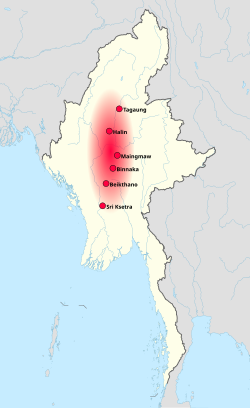
Back دول مدينة بيو Arabic Civilización pyu AST Пью (ҡала-дәүләттәр) Bashkir П’ю Byelorussian ပျူခမ်းဝေင်ꩻတန်ဖုံႏ BLK Ciutats estat pyu Catalan Městské státy Pyu Czech Pyu German Civilización pyu Spanish Pyu hiri-estatuak Basque
Pyu city-states ပျူ မြို့ပြ နိုင်ငံများ | |||||||||
|---|---|---|---|---|---|---|---|---|---|
| c. 2nd century BCE–c. 1050 | |||||||||
 The Pyu realm in the red zone | |||||||||
| Capital | Sri Ksetra, Halin, Beikthano, Pinle, Binnaka | ||||||||
| Common languages | Pyu | ||||||||
| Religion | Theravada Buddhism, Mahayana Buddhism, Tantric Buddhism | ||||||||
| Government | Monarchy | ||||||||
| Historical era | Classical antiquity | ||||||||
• Earliest Pyu presence in Upper Burma | c. 2nd century BCE | ||||||||
• Beikthano founded | c. 180 BCE | ||||||||
• Pyu converted to Buddhism | 4th century | ||||||||
• Burmese calendar begins | 22 March 638[1] | ||||||||
• 2nd Sri Ksetra Dynasty founded | 25 March 739 | ||||||||
• Rise of Pagan Empire | c. 1050 | ||||||||
| |||||||||
| UNESCO World Heritage Site | |
|---|---|
| Location | Myanmar |
| Includes | |
| Criteria | Cultural: (ii)(iii)(iv) |
| Reference | 1444 |
| Inscription | 2014 (38th Session) |
| Area | 5,809 ha (14,350 acres) |
| Buffer zone | 6,790 ha (16,800 acres) |
| Coordinates | 22°28′12″N 95°49′7″E / 22.47000°N 95.81861°E |
| History of Myanmar |
|---|
 |
|
|
|
|
|
|
The Pyu city-states (Burmese: ပျူ မြို့ပြ နိုင်ငံများ, simplified Chinese: 骠国; traditional Chinese: 驃國; pinyin: Biāoguó) were a group of city-states that existed from about the 2nd century BCE to the mid-11th century in present-day Upper Myanmar (Burma). The city-states were founded as part of the southward migration by the Tibeto-Burman-speaking Pyu people, the earliest inhabitants of Burma of whom records are extant.[2] The thousand-year period, often referred to as the Pyu millennium, linked the Bronze Age to the beginning of the classical states period when the Pagan Kingdom emerged in the late 9th century.
The major Pyu city-states were all located in the three main irrigated regions of Upper Burma: the Mu River Valley, the Kyaukse plains and Minbu region, around the confluence of the Irrawaddy and Chindwin Rivers. Five major walled cities- Beikthano, Maingmaw, Binnaka, Hanlin, and Sri Ksetra- and several smaller towns have been excavated throughout the Irrawaddy River basin. Hanlin, founded in the 1st century AD, was the largest and most important city until around the 7th or 8th century when it was superseded by Sri Ksetra (near modern Pyay) at the southern edge of the Pyu Realm. Twice as large as Halin, Sri Ksetra was eventually the largest and most influential Pyu centre.[2] Only the city-states of Halin, Beikthano and Sri Ksetra are designated as UNESCO World Heritage Sites, where the other sites can be added in the future for an extension nomination.[3]
The Pyu realm was part of an overland trade route between China and India. The Pyu culture was heavily influenced by trade with India, importing Buddhism as well as other cultural, architectural and political concepts, which would have an enduring influence on the political organisation and culture of Burma.[4] The Pyu calendar, based on the Buddhist calendar, later became the Burmese calendar. The Pyu script, based on the Brahmi script, may have been the source of the Burmese script used to write the Burmese language.[5][6]
The millennium-old civilisation came crashing down in the 9th century when the city-states were destroyed by repeated invasions from the Kingdom of Nanzhao. The Bamar people set up a garrison town at Bagan (Pagan) at the confluence of the Irrawaddy and Chindwin Rivers. Pyu settlements remained in Upper Burma for the next three centuries but the Pyu gradually were absorbed into the expanding Pagan Kingdom. The Pyu language still existed until the late 12th century. By the 13th century, the Pyu had assumed the Burman ethnicity. The histories and legends of the Pyu were also incorporated to those of the Bamar.[4]
- ^ Aung-Thwin (2005), p. 24
- ^ a b Hall 1960: 8–10
- ^ "Pyu Ancient Cities". Ahc.unesco.org. Archived from the original on 8 July 2018. Retrieved 16 January 2018.
- ^ a b Myint-U 2006: 51–52
- ^ Jenny, Mathias (2015). "Foreign Influence in the Burmese Language" (PDF). p. 2. Archived (PDF) from the original on 20 March 2023. Retrieved 20 March 2023.
- ^ Aung-Thwin 2005, p. 167–178, 197–200.